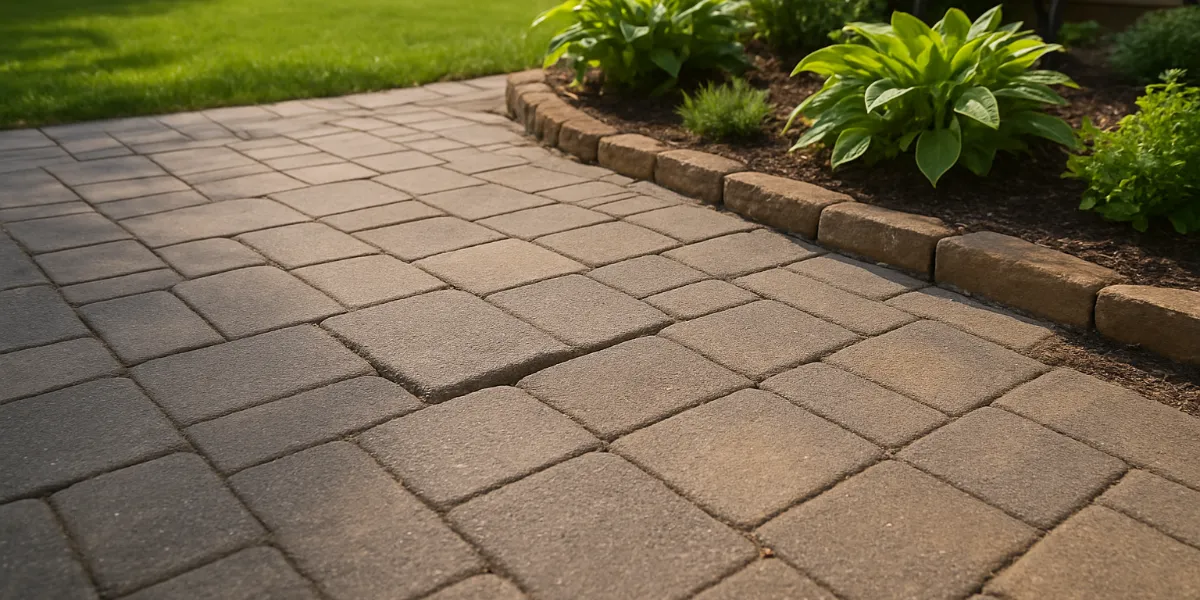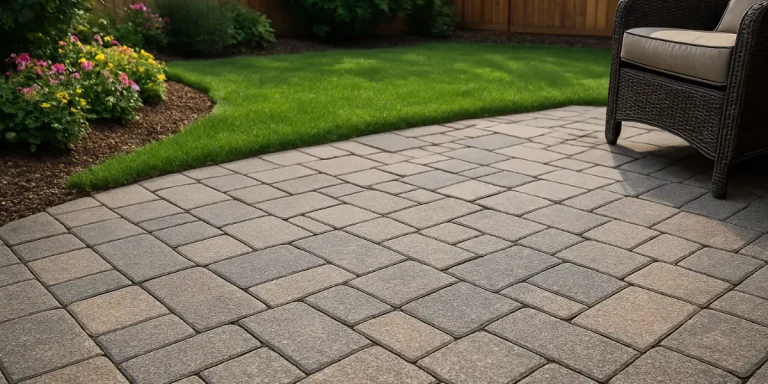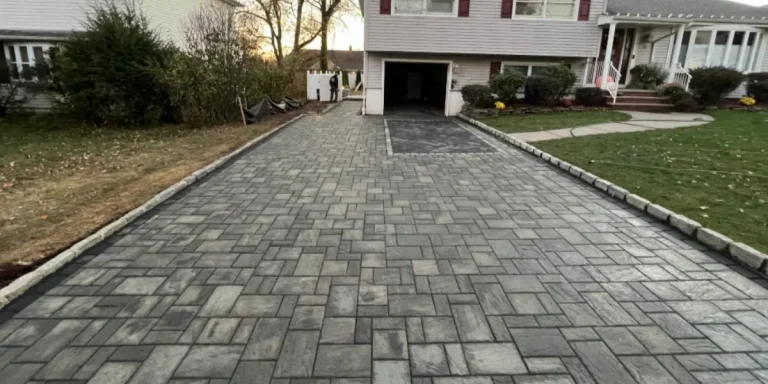What to Do When Patio Pavers Start to Sink

Sinking patio pavers are more than just an eyesore—they can create tripping hazards, damage surrounding hardscapes, and signal deeper problems with your landscape’s foundation or drainage. If you've noticed low spots, uneven surfaces, or puddling after rain, it’s time to take action.
At JBS Landscaping, we help homeowners throughout Columbia, New Jersey, and surrounding towns restore the beauty, safety, and durability of their patios. Here's what causes pavers to sink and how we professionally repair them to prevent future problems.
Why do patio pavers sink?
Patio pavers are engineered to be durable, but their longevity depends heavily on the foundation underneath. When that base fails—whether due to poor construction, drainage issues, or natural wear—the pavers above begin to shift, settle, and eventually sink. This not only affects appearance but also creates tripping hazards and drainage problems across your outdoor space.
Here are the most common reasons patio pavers sink—and what they mean for your yard:
Poor base preparation
The most common cause of sinking pavers is an improperly built base. If the gravel layer beneath the pavers wasn’t deep enough, compacted properly, or evenly distributed, the soil will settle unevenly under pressure—especially after rainfall.
-
- A shallow base may compress under foot traffic or patio furniture
- Loose or ungraded materials can wash out over time
- Skipping proper compaction leads to soft spots and instability
At JBS Landscaping, we follow industry-best practices to ensure every patio is built on a stable, well-compacted base that won’t settle or shift with seasonal changes.
Water erosion
Water is a silent destroyer of hardscapes. When your patio lacks proper drainage, rainwater or melting snow can seep below the pavers, slowly washing away the gravel or bedding sand underneath.
-
- Undirected roof runoff from gutters or downspouts can flood the base
- Low-lying patios without grading can collect stormwater
- Poor joint sealing allows water to filter through the surface
If not addressed, erosion will create air pockets beneath your patio, causing sinking and cracking over time. We specialize in landscape drainage solutions, including swales, French drains, and downspout redirection to eliminate the root cause of water damage.
Improper edging
Edge restraints are what keep your pavers locked tightly in place. Without them—or if they’re loose or broken—pavers can slowly migrate outward. As the perimeter spreads, the interior pavers begin to shift, creating sunken areas or gaps.
-
- Missing or weak edging allows lateral movement
- Freeze-thaw cycles can lift or dislodge edge restraints
- Edging that wasn’t anchored deeply may fail under pressure
JBS Landscaping installs professional-grade edge restraints on every hardscape project to ensure long-term structural integrity.
Heavy foot or vehicle traffic
Even with a solid base, repeated use can compress isolated sections—especially in high-traffic zones like walkways, outdoor dining areas, or driveways. If the base wasn't compacted properly or reinforced for heavier loads, pressure from constant use will eventually cause dips and uneven spots.
-
- Furniture legs and grills can create pressure points
- Footpaths and play areas may wear faster over time
- Driveways or patios used for parking require a reinforced sub-base
When repairing these areas, we often rebuild the base using denser aggregate and deeper excavation to support the additional load.
Frost heave and freeze-thaw cycles
In colder climates like New Jersey, winter brings a unique challenge: frost heave. When moisture in the soil freezes, it expands—lifting the pavers. As the ground thaws, it contracts, sometimes leaving air gaps below. Over repeated cycles, this leads to uneven settling and instability.
-
- Water trapped beneath the pavers causes soil to expand and contract
- Poor drainage amplifies the problem by keeping the base saturated
- Without frost-resistant installation, patios quickly lose their shape
JBS Landscaping is experienced in building patios to handle local climate conditions. We use frost-resistant base materials, proper jointing sand, and drainage strategies that prevent winter damage.
Understanding why your pavers are sinking is the first step toward fixing the problem—and preventing it from happening again. At JBS Landscaping, we don’t just patch the surface. We identify the cause, rebuild the base if necessary, and reinforce the surrounding landscape so your patio looks and performs its best for years to come.
Step-by-step: How to fix sinking patio pavers
1. Remove the affected pavers
The repair process starts by carefully lifting the pavers that have sunk. This step gives us access to the underlying base materials and helps determine the full extent of the issue.
-
-
- Use flat tools or lifters to remove pavers without cracking them
- Set aside undamaged pavers for reuse during the reset
- Inspect the surrounding area to assess whether the problem is localized or widespread
- Expand the work area if necessary to ensure a consistent, long-lasting repair
-
At JBS Landscaping, we take care to protect your existing materials and assess the site thoroughly before moving forward.
2. Inspect and repair the base
The integrity of the base is what keeps your pavers level over time. If the base has eroded, compacted unevenly, or was installed improperly, it must be rebuilt to industry standards.
-
-
- Examine the depth and condition of the gravel or stone base
- Remove soft, wet, or eroded base materials that won’t provide stability
- Re-compact the remaining sub-base using heavy-duty plate compactors
- Add fresh crushed stone or quarry process (Q.P.) to restore the correct depth
- Compact the new base in layers to ensure long-term durability
-
JBS Landscaping uses high-quality materials and precise leveling techniques to deliver lasting results that outperform DIY fixes.
3. Adjust for proper drainage
Without proper drainage, even a new base can fail. Water collecting beneath or around your patio can wash away materials and cause repeated settling.
-
-
- Check for drainage issues such as nearby downspouts or pooling areas
- Install or extend downspouts to move water away from the patio
- Consider adding a swale or French drain to redirect runoff
- Switch to permeable polymeric sand to allow water to pass through joints
- Regrade the surrounding landscape if necessary to improve water flow
-
Our team at JBS Landscaping specializes in drainage correction and grading services, making sure your patio isn’t just repaired—it’s protected.
4. Reset and level the pavers
With the base repaired and drainage addressed, we reset the pavers to restore a smooth, even surface that matches the original layout.
-
-
- Spread a fresh, level layer of bedding sand (typically 1 inch thick)
- Lay each paver back in place, checking for alignment and even spacing
- Tap pavers gently into position using rubber mallets and leveling tools
- Use polymeric joint sand to fill gaps and stabilize the surface
- Compact the entire area to lock pavers into place and reduce movement
-
If any pavers are cracked, discolored, or outdated, we can replace them with new materials that complement your landscape design.
5. Reinforce the edges
Strong edge support is essential to prevent shifting and spreading over time. Poor or missing edging is a common cause of recurring patio issues.
-
-
- Inspect existing edge restraints and remove any that are damaged or ineffective
- Install new steel, aluminum, or concrete edge restraints depending on the project needs
- Secure edges with landscape spikes or anchors for long-term support
- Backfill around the patio edge with soil or stone to improve appearance and stability
-
At JBS Landscaping, we reinforce all patio repairs with professional-grade edge systems to preserve your investment and extend the life of your hardscape.
Mini case study: Patio repair in Budd Lake, NJ
A client in Budd Lake contacted us about a sinking section of their paver patio that had begun pooling water after every rainstorm. Upon inspection, we discovered the sub-base had eroded due to poor drainage from a nearby downspout.
Our team removed the affected area, excavated and rebuilt the base with compacted gravel, added a downspout extension, and reset the pavers. After a recent storm, the client reported no standing water and a patio that looked brand new.
How to prevent pavers from sinking in the future
While high-quality installation is the best long-term protection, there are a few maintenance practices that can help keep your patio in great shape:
-
- Keep joints filled with polymeric sand to block water infiltration
- Reroute downspouts and avoid directing runoff toward hardscaped areas
- Watch for early signs of shifting and contact a professional promptly
- Seal your pavers to protect the surface and reduce water absorption (optional)
JBS Landscaping offers hardscaping maintenance, drainage upgrades, and landscape grading services that support the long-term performance of your patio and walkways.
Proudly serving Columbia and surrounding areas
JBS Landscaping provides expert patio repair, paver installation, and landscape drainage services throughout Morris, Sussex, and Warren Counties, including:
-
- Columbia
- Allamuchy
- Budd Lake
- Chester
- Flanders
- Hackettstown
- Long Valley
- Newton
- Rockaway
- Sparta
- Succasunna
Whether you're dealing with a few sunken pavers or an entire patio in need of restoration, we’re here to help.
Ready to fix your sinking patio pavers?
Schedule a patio repair consultation with JBS Landscaping
If your patio pavers are sinking, don’t wait for the damage to spread or create a safety hazard. Contact JBS Landscaping today to schedule an inspection. We’ll assess the cause, explain your options, and restore your patio to a safe, stable, and beautiful condition.
We proudly serve homeowners in Columbia, NJ and nearby towns with trusted hardscaping and landscaping services built to last.



